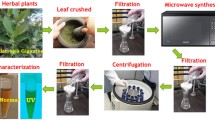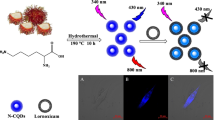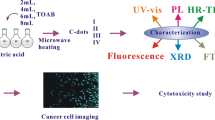Abstract
In the study, fluorescent imaging of live cells was performed using fluorescent carbon quantum dots derived from edible mushrooms species; Agaricus bisporus, Pleurotus ostreatus, and Suillus luteus as a fluorophore agent. Carbon quantum dots were synthesized through a facile and low-cost method based on microwave irradiation of dried mushroom samples in hydrogen peroxide solution under optimized conditions (microwave energy, solution type, duration of microwave treatment, amount of mushroom). Upon purification with centrifugation, microfiltration, and dialysis, the lyophilized carbon quantum dots were identified through UV–visible, fluorescence and FT-IR, X-ray photoelectron spectroscopy, X-ray diffraction, high-resolution transmission electron microscopy, and quantum yield calculation. Cell viability assessment of the carbon quantum dots was evaluated against human epithelial cell line PNT1A using the Alamar Blue Assay. In vitro fluorescence cell imaging studies demonstrated that the carbon dots could dynamically penetrate the cell membrane and nuclear membrane and localize in both the cytoplasm and the nucleus.










Similar content being viewed by others
References
Kalaiyarasan G, Joseph J (2019) Cholesterol derived carbon quantum dots as fluorescence probe for the specific detection of hemoglobin in diluted human blood samples. Mater Sci Eng, C 94:580–586
Venkateswarlu S, Viswanath B, Reddy AS, Yoon M (2018) Fungus-derived photoluminescent carbon nanodots for ultrasensitive detection of Hg2+ ions and photoinduced bactericidal activity. Sens Actuators, B Chem 258:172–183
Das R, Bandyopadhyay R, Pramanik P (2018) Carbon quantum dots from natural resource: A review. Materials today chemistry 8:96–109
Molaei MJ (2019) A review on nanostructured carbon quantum dots and their applications in biotechnology, sensors, and chemiluminescence. Talanta 196:456–478
Peng Z, Han X, Li S, Al-Youbi AO, Bashammakh AS, El-Shahawi MS et al (2017) Carbon dots: biomacromolecule interaction, bioimaging and nanomedicine. Coord Chem Rev 343:256–277
Song Y, Shi W, Chen W, Li X, Ma H (2012) Fluorescent carbon nanodots conjugated with folic acid for distinguishing folate-receptor-positive cancer cells from normal cells. J Mater Chem 22(25):12568–12573
Cheng C, Shi Y, Li M, Xing M, Wu Q (2017) Carbon quantum dots from carbonized walnut shells: structural evolution, fluorescence characteristics, and intracellular bioimaging. Mater Sci Eng, C 79:473–480
Kirchner C, Liedl T, Kudera S, Pellegrino T, Muñoz Javier A, Gaub HE et al (2005) Cytotoxicity of colloidal CdSe and CdSe/ZnS nanoparticles. Nano Lett 5(2):331–338
Sun Y-P, Zhou B, Lin Y, Wang W, Fernando KS, Pathak P et al (2006) Quantum-sized carbon dots for bright and colorful photoluminescence. J Am Chem Soc 128(24):7756–7757
Cao L, Wang X, Meziani MJ, Lu F, Wang H, Luo PG et al (2007) Carbon dots for multiphoton bioimaging. J Am Chem Soc 129(37):11318–11319
Lim SY, Shen W, Gao Z (2015) Carbon quantum dots and their applications. Chem Soc Rev 44(1):362–381
Yang Y, Cui J, Zheng M, Hu C, Tan S, Xiao Y et al (2012) One-step synthesis of amino-functionalized fluorescent carbon nanoparticles by hydrothermal carbonization of chitosan. Chem Commun 48(3):380–382
Yin B, Deng J, Peng X, Long Q, Zhao J, Lu Q et al (2013) Green synthesis of carbon dots with down-and up-conversion fluorescent properties for sensitive detection of hypochlorite with a dual-readout assay. Analyst 138(21):6551–6557
Zhou J, Sheng Z, Han H, Zou M, Li C (2012) Facile synthesis of fluorescent carbon dots using watermelon peel as a carbon source. Mater Lett 66(1):222–224
Wen Q, Liu L, Yang Q, Lv F, Wang S (2013) Dopamine-Modified Cationic Conjugated Polymer as a New Platform for pH Sensing and Autophagy Imaging. Adv Func Mater 23(6):764–769
Yu T, Wang H, Guo C, Zhai Y, Yang J, Yuan J (2018) A rapid microwave synthesis of green-emissive carbon dots with solid-state fluorescence and pH-sensitive properties. R Soc Open Sci 5(7):180245
Wang Y, Hu A (2014) Carbon quantum dots: synthesis, properties and applications. J Mater Chem C 2(34):6921–6939
Zhang Y, Liu X, Fan Y, Guo X, Zhou L, Lv Y et al (2016) One-step microwave synthesis of N-doped hydroxyl-functionalized carbon dots with ultra-high fluorescence quantum yields. Nanoscale 8(33):15281–15287
Li H, Shao F-Q, Zou S-Y, Yang Q-J, Huang H, Feng J-J et al (2016) Microwave-assisted synthesis of N, P-doped carbon dots for fluorescent cell imaging. Microchim Acta 183(2):821–826
Yang S-T, Cao L, Luo PG, Lu F, Wang X, Wang H et al (2009) Carbon dots for optical imaging in vivo. J Am Chem Soc 131(32):11308–11309
Ahn J, Song Y, Kwon JE, Lee SH, Park KS, Kim S et al (2019) Food waste-driven N-doped carbon dots: Applications for Fe3+ sensing and cell imaging. Mater Sci Eng, C 102:106–112
Zhang X, Jiang M, Niu N, Chen Z, Li S, Liu S et al (2018) Natural-product-derived carbon dots: from natural products to functional materials. Chemsuschem 11(1):11–24
Kumari B, Kumari R, Das P (2018) Visual detection of G-quadruplex with mushroom derived highly fluorescent carbon quantum dots. J Pharm Biomed Anal 157:137–144
Sargin I, Yanalak G, Arslan G, Patir IH (2019) Green synthesized carbon quantum dots as TiO2 sensitizers for photocatalytic hydrogen evolution. Int J Hydrogen Energy 44(39):21781–21789
Pacquiao MR, de Luna MDG, Thongsai N, Kladsomboon S, Paoprasert P (2018) Highly fluorescent carbon dots from enokitake mushroom as multi-faceted optical nanomaterials for Cr6+ and VOC detection and imaging applications. Appl Surf Sci 453:192–203
Boobalan T, Sethupathi M, Sengottuvelan N, Kumar P, Balaji P, Gulyás B et al (2020) Mushroom-derived carbon dots for toxic metal ion detection and as antibacterial and anticancer agents. ACS Appl Nano Mater 3(6):5910–5919
Zulfajri M, Rasool A, Huang GG (2020) A fluorescent sensor based on oyster mushroom-carbon dots for sensing nitroarenes in aqueous solutions. New J Chem 44(25):10525–10535
Wang WJ, Xia JM, Feng J, He MQ, Chen ML, Wang JH (2016) Green preparation of carbon dots for intracellular pH sensing and multicolor live cell imaging. J Mater Chem B 4(44):7130–7137
Chandra A, Singh N (2017) Biocompatible fluorescent carbon dots for ratiometric intracellular pH sensing. ChemistrySelect 2(20):5723–5728
Zhang N, Chen H, Zhang Y, Xing L, Li S, Wang X et al (2015) Chemical composition and antioxidant properties of five edible Hymenomycetes mushrooms. Int J Food Sci Technol 50(2):465–471
Williams ATR, Winfield SA, Miller JN (1983) Relative fluorescence quantum yields using a computer-controlled luminescence spectrometer. Analyst 108(1290):1067–1071
Yvon HJ (2012) A guide to recording fluorescence quantum yields. HORIBA Jobin Yvon Inc, Stanmore, Middlesex, UK
Karakurt S, Adali O (2016) Tannic acid inhibits proliferation, migration, invasion of prostate cancer and modulates drug metabolizing and antioxidant enzymes. Anti-Cancer Agents in Medicinal Chemistry (Formerly Current Medicinal Chemistry-Anti-Cancer Agents). 16(6):781–789
Erdemir S, Kocyigit O, Karakurt S (2015) A new perylene bisimide-armed calix[4]-aza-crown as “turn on” fluorescent sensor for Hg2+ ion and its application to living cells. Sens Actuators, B Chem 220:381–388
Feng H, Dong H, Lei B, Xiao Y, Hu H, Zhan H et al (2016) One-Pot H2O2-Assisted Hydrothermal Carbonization for the Synthesis of Fluorescent Graphene Quantum Dots Derived from Sewage Sludge. Sci Adv Mater 8(5):948–955
Shi C, Qi H, Ma R, Sun Z, Xiao L, Wei G, et al (2019) N, S-self-doped carbon quantum dots from fungus fibers for sensing tetracyclines and for bioimaging cancer cells. Mater Sci Eng C 105:110132
Guo L, Li L, Liu M, Wan Q, Tian J, Huang Q et al (2018) Bottom-up preparation of nitrogen doped carbon quantum dots with green emission under microwave-assisted hydrothermal treatment and their biological imaging. Mater Sci Eng, C 84:60–66
Funding
This project study was funded by Selcuk University Research Foundation (project number: BAP-19401118).
Author information
Authors and Affiliations
Contributions
Conceptualization: [Gulsin Arslan, Idris Sargin, Sedar Karakurt]; Design: [Gulsin Arslan, Idris Sargin, Sedar Karakurt]; Material preparation: [Gulsin Arslan, Idris Sargin, Sinan Alkan]; Data collection and analysis: [Gulsin Arslan, Idris Sargin, Serdar Karakurt]; Writing-original draft: [Gulsin Arslan, Idris Sargin, Serdar Karakurt]; Mushrooms’species identification: [Sinan Alkan].
Corresponding author
Ethics declarations
Consent for Publication
All the authors read and approved the final manuscript to the journal.
Conflicts of Interest
The authors declare that they have no known competing financial interests or personal relationships that could have appeared to influence the work reported in this paper.
Additional information
Publisher's Note
Springer Nature remains neutral with regard to jurisdictional claims in published maps and institutional affiliations.
Supplementary Information
Below is the link to the electronic supplementary material.
Rights and permissions
About this article
Cite this article
Sargin, I., Karakurt, S., Alkan, S. et al. Live Cell Imaging With Biocompatible Fluorescent Carbon Quantum Dots Derived From Edible Mushrooms Agaricus bisporus, Pleurotus ostreatus, and Suillus luteus. J Fluoresc 31, 1461–1473 (2021). https://doi.org/10.1007/s10895-021-02784-3
Received:
Accepted:
Published:
Issue Date:
DOI: https://doi.org/10.1007/s10895-021-02784-3




